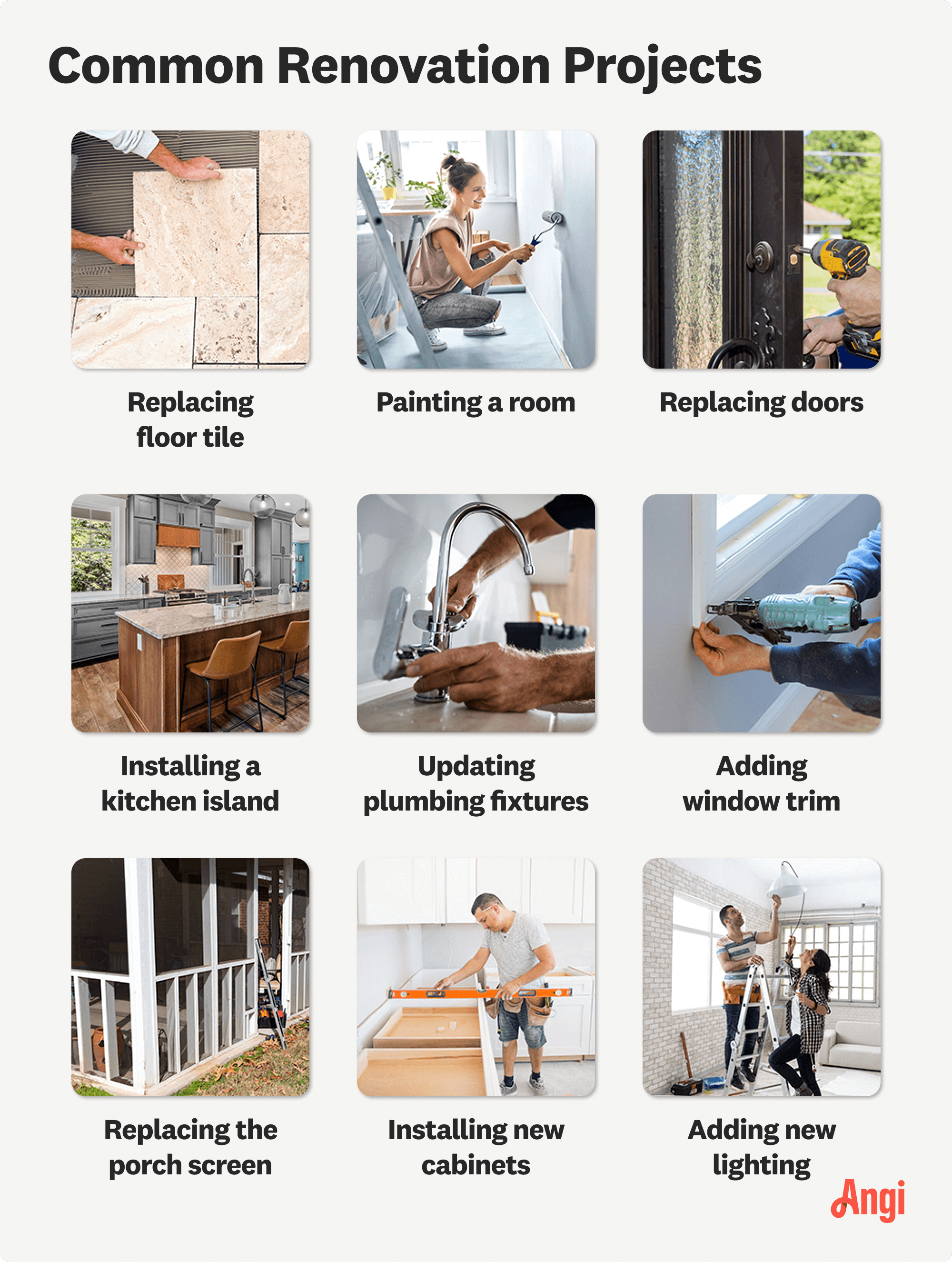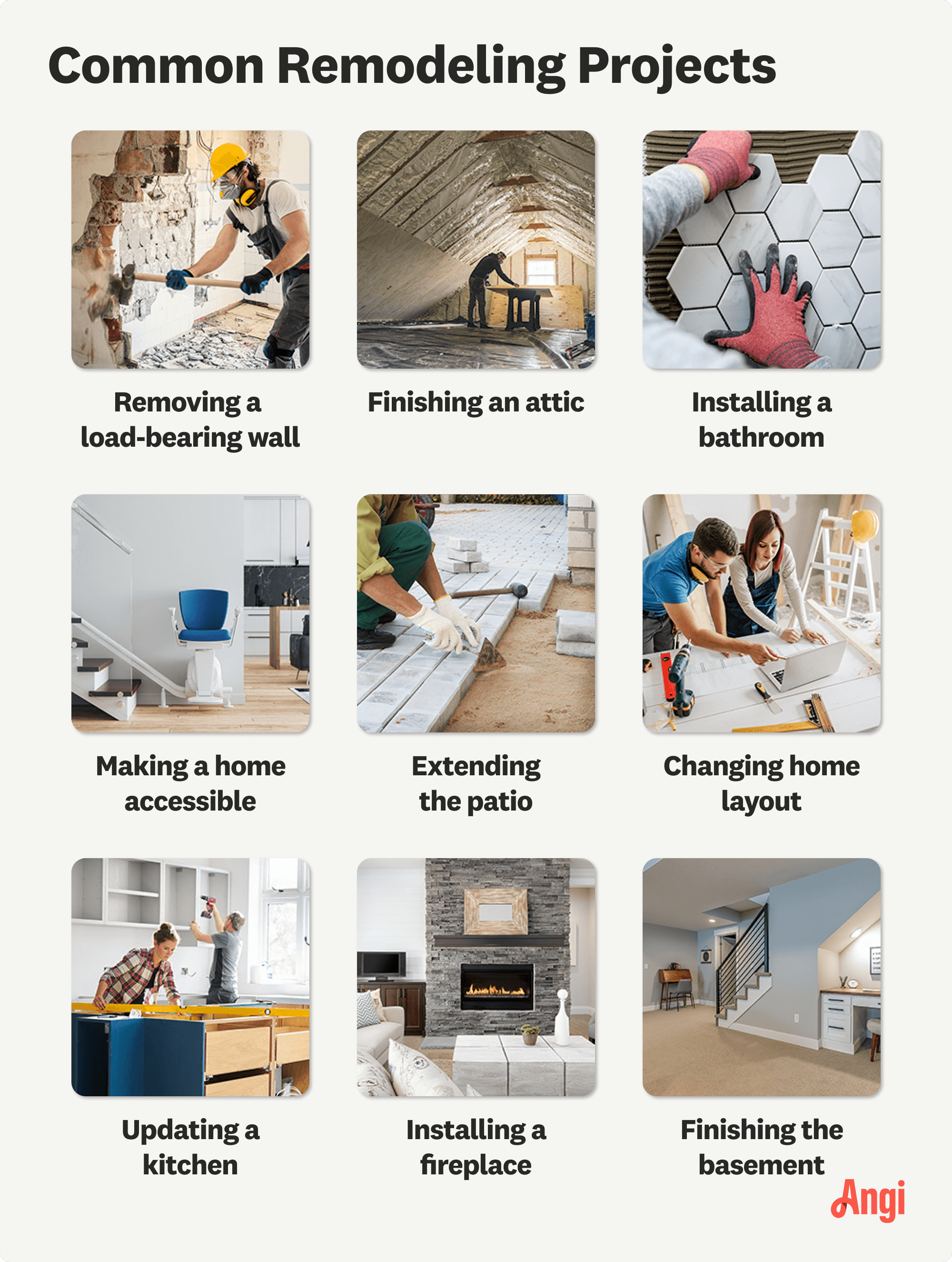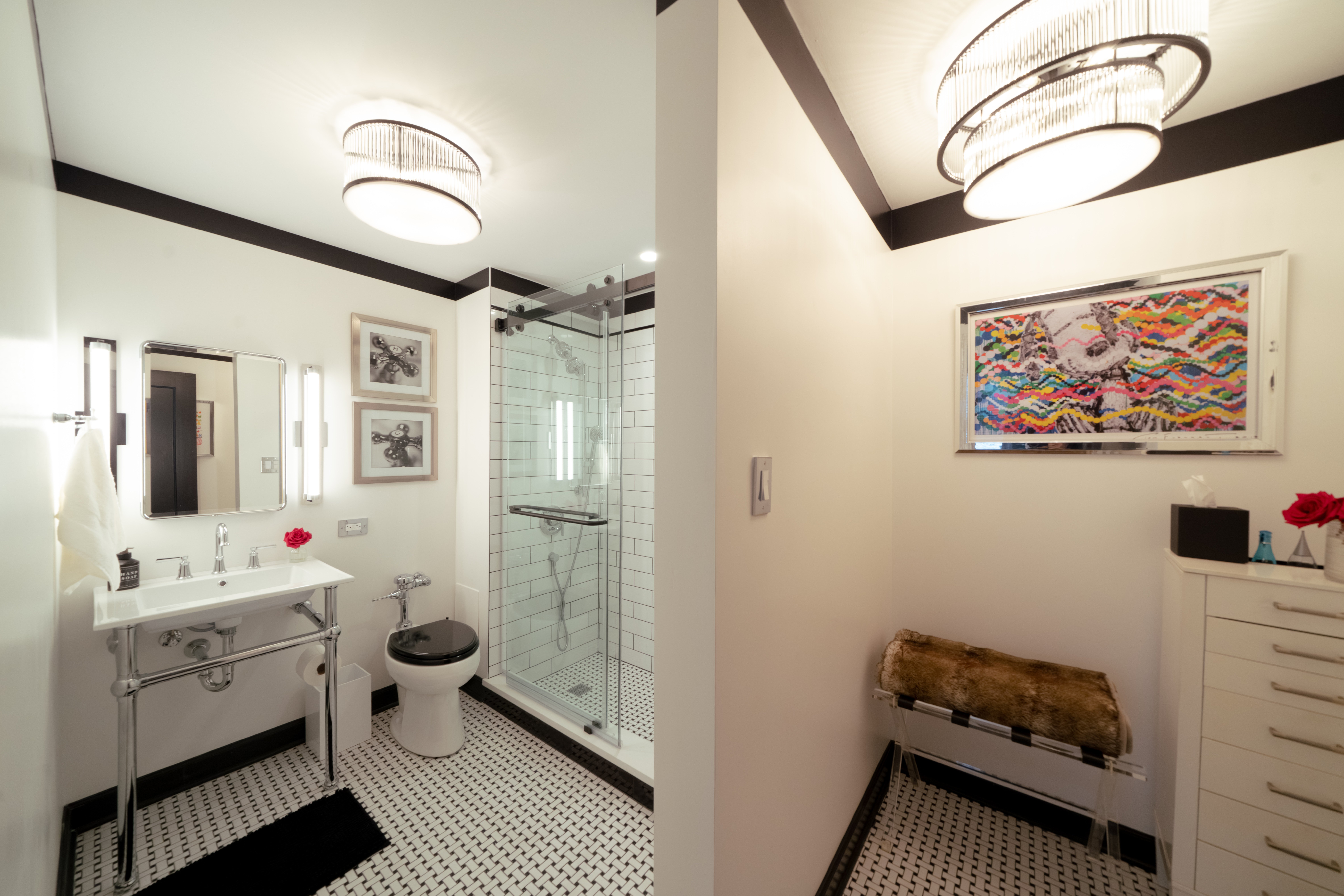
Bathroom cabinet costs can easily skyrocket. Take a look at these important cost factors and considerations to help you stay within your budget.
Is it tomato, tomah-to, or are there real differences?


A renovation refers to restoring something to a previous state.
A remodel refers to creating something new.
The majority of remodeling projects require permits and a professional.
While you'll typically pay less for a renovation, it may not address any underlying issues.
People often confuse the terms “renovation” and “remodeling,” and it’s easy to see why, as these project types do feature some similarities. A remodel versus a renovation are actually quite different, so if you’re meeting with a remodeling contractor near you about a home improvement project, you’ll want to have your definitions straight. Once you understand the differences between the two, it will be easier to decide what kind of eye-popping alterations to make within your home.
Deciding between a remodel and a renovation will become clearer once you understand the difference between the terms.
Many people use the terms 'remodel' and 'renovation' interchangeably, but they're actually different types of projects. A remodel is larger than a renovation and changes an existing space's structure, design, or functionality. A renovation is more cosmetic. You can think of it like this—a renovation makes something old look and feel new, while a remodel makes something new out of something old.
A home renovation means that something has been updated–like finishes, fixtures, and minor structural elements–but not completely changed.The updates may encompass both interior and exterior changes, but many are DIY-friendly, and don't require extensive permitting or city approval.
A house remodel, on the other hand, implies major changes–like knocking down walls, moving plumbing, or changing the layout of a room. A remodel affects the parts of a house, such as its framing, the roof, or the foundation. It could affect load-bearing walls, your home's square footage, or the structure of your landscape. A remodel nearly always requires the work of a trained professional.

A renovation improves, refreshes, or restores an existing home with updated, more aesthetically-pleasing finishes. Installing new flooring, replacing a kitchen faucet, or painting a bedroom’s walls are all great examples of a renovation–it updates the feel or look of a room, but will not change the room’s purpose.
Generally speaking, a renovation can be DIY-friendly, and a good pick for amateur enthusiasts looking to spruce up a home without putting their whole life on hold.
| Pros | Cons |
|---|---|
| Lower cost | Doesn't address structural issues |
| DIY-able options | Often a short-term fix |
| High return on investment (ROI) | Does not alter floor plans |
Best for: Stylistic upgrades and DIY projects
Renovating can be an affordable way to update your space without taking out a second mortgage. Small renovations, like painting the walls, swapping out fixtures, or installing new lighting, can make a big impact even when you have a small budget.
While not every aspect of a potential renovation project may be DIY-friendly, you don’t need the expertise or experience of a pro to undertake minor renovations on your own.
Renovations can also offer a good return on investment (ROI). Because renovating tends to have an affordable overall cost, it’s an excellent way to quickly boost your home's value.
One drawback of a renovation is that it won’t correct a poor home or room design. Renovations don’t change how functional your space is or correct major structural issues.
The cost of renovating a house is often less than remodeling it, but underlying costs can add up over the years. Staining your porch is not the same as replacing broken or decaying boards, for example.
Finally, a renovation doesn’t include knocking down walls or building floor plans. Upgrading the flow of a house requires a remodeling team.

A home remodel tends to involve significant functional changes to the design and layout of a home. Reconfiguring a kitchen, building an addition, and expanding a bathroom are all good remodeling examples.
A remodel could alter the actual structure of a house and change the purpose of a room, such as turning a guest bedroom into a home office. You may need to remove walls, replace windows, and acquire building permits. In other words, a remodel is better left to professional contractors unless you have some serious time on your hands.
| Pros | Cons |
|---|---|
| Improve functionality | High costs |
| Prolongs the life of a home | Longer timeline |
| Invites a team of professionals | May require a permit |
Best for: Structural and functional changes to your home
A huge perk of a remodel is that it can drastically improve your home’s functionality. Remodeling allows you to change the layout and design of your home to ensure every inch of space can be used exactly as you need it to be.
Remodeling can also increase your home’s lifespan because it allows you to address structural issues that can increase the long-term integrity of your home.
Finally, you’ll get a lot of helpful input from remodeling professionals. Hiring an architect to plan and complete your remodel often means that you’re hiring someone with expertise and experience, and pros are often excited to complete large jobs with lots of room to get creative.
One of the biggest drawbacks of a remodel is that it can be expensive. Remodeling often comes with significant costs that can be prohibitive to many homeowners. For example, you need to budget for the cost of a structural engineer when altering load-bearing walls or changing floor plans.
A remodel also requires a longer timeline. While your exact timeline will vary depending on your project goals, remodeling is often a process that takes at least several months to complete.
Finally, your remodel will likely require one or more permits. The cost of a building permit adds an average of $1,600 to your bottom line.
As you think about the future of your home and the outcome you desire, you’ll need to consider several factors to determine if a renovation or remodel is the best choice for you.
Renovating generally costs much less than remodeling. If you are lightly renovating a 2,500-square-foot home, you can make a series of high-impact updates such as landscaping, paint, flooring, or countertops for around $15,000.
Performing an extensive home remodel comes with some serious dollar signs attached. Make no mistake, it’s a next-level #adulting investment that includes the cost of blueprints, permits, and even higher property taxes in the long run. The cost to remodel multiple rooms in your home averages $47,000.
It’s unlikely that a home renovation project will require a building permit. You can perform simple renovations, such as putting in new carpeting, without having to contact a local regulatory agency. Some renovation projects, like replacing a roof, may require a building permit or the approval of a community board, though they will be the exception and not the rule.
If you are planning a major remodeling project, though, you will likely have to get building permits and consent from local community boards. It’s common in most parts of the country for a building authority to require a permit whenever a structure is changed. If you’re doing anything with your home’s foundation, walls, ceilings, or roof, your contractor may suggest that you hire an inspector, and get the necessary permits.
Renovations can take as little as a few days to complete. If you’re painting a room, replacing hardware, or adding new flooring, you can anticipate a relatively quick turnaround from project ideation to completion.
Remodeling usually takes quite a bit longer than renovating. Many pros have waitlists, materials can be out of stock, and the sort of work that must be done often just takes a significant amount of time.
If you’re looking to change the look and feel of your home, a renovation may be all you need. If you want to increase functionality or longevity though, you’ll need to invest in a remodel.
Remodeling will allow you to shift your layout, create highly functional spaces and ensure that any underlying or structural issues are taken care of.
Believe it or not, renovating offers a better ROI than a whole-home remodeling project. The relatively inexpensive nature of renovations, combined with increased home value, makes many renovations worth it. Some projects, like renovating your bathroom, can yield an ROI of 60%.
Additionally, the ROI of some home remodeling projects will be slightly lower than what has been reported with renovation projects, due to the high buy-in cost. For example, the ROI on raising your roof falls around 50%.
From average costs to expert advice, get all the answers you need to get your job done.

Bathroom cabinet costs can easily skyrocket. Take a look at these important cost factors and considerations to help you stay within your budget.

Building a laundry room addition to your home adds value and functionality. Your laundry room addition cost will depend on size, materials, and other factors.

Small kitchen remodels cost $12,750 on average, depending on the materials, size, labor, and more. Read this to calculate your kitchen remodel costs.

An outdated bathroom is transformed into a vintage-inspired space with basketweave floor tile, a console sink, and subway tile.

This prep and staging area has numerous uses in the versatile modern home. Here’s what a butler’s pantry does and how you can add one to your home.

Undermounted sinks are elegant upgrades to any kitchen and can add to your home’s resale value. But are they the best option? Here we’ll learn the pros and cons of having an undermount sink.